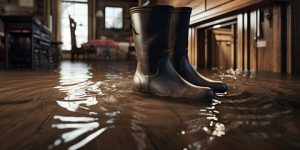Water damage, if not addressed quickly and properly, can lead to more costly repairs in the future. Identifying the source of the water, turning off the power, and removing or drying out all affected areas are essential steps in the repair process.

Every moment you wait can exponentially increase the severity of water damage, leading to extended periods of restoration and higher costs. Contact Water Damage Repair Utah for professional help.
Water damage can be very dangerous if it isn’t handled in a timely manner. Fortunately, professional water damage repair can mitigate the risks of structural failure. This ensures that buildings stay safe and secure for their occupants.
Structural damage affects a building’s core parts like walls that bear weight and the foundation. It’s very important to identify and address issues such as a leaking roof or a damp basement before they worsen. In addition, home and business owners should read their insurance policies carefully to understand what kinds of damage they’re covered for.
Over time, water can erode and weaken building materials like wood, drywall, and concrete. This makes them less able to withstand heavy loads and creates ideal conditions for mold growth. As a result, they may warp or collapse if not properly repaired.
Prompt water damage repairs can protect buildings from the deterioration of key support structures and prevent costly reconstruction efforts in the future. In severe cases, structural shifts and collapses can compromise safety and lead to disastrous consequences for people inside the building.
Regular inspections of water damage can help keep buildings in good condition. However, it’s essential to hire IICRC-certified professionals to do an in-depth inspection and restoration of a property to address all problems as they arise.
If you spot any signs of water damage, contact a professional for immediate water removal and damage mitigation services. They can perform non-invasive moisture detection to pinpoint the source of the problem and implement effective solutions to minimize the impact on your building and its occupants.
They’ll use industrial-grade pumps, dehumidifiers, and specialized drying equipment to remove excess moisture from the affected area. They’ll also provide structural repair and reconstruction if necessary to restore the integrity of damaged walls, ceilings, floors, and other interior elements. Additionally, they’ll employ containment strategies to limit the spread of contaminants and mold to unaffected areas and speed up the restoration process. In addition, they’ll help you navigate the insurance claims process. They’ll also advise on ways to prevent future water damage, such as regular maintenance and addressing any leaks promptly.
Reduces Stress
When water damage occurs, it’s important to act quickly. Delays can lead to structural damage, mold growth, and other complications. Thankfully, timely water damage repair can mitigate these issues and help you save money in the long run.
Water restoration and repair can be a stressful process, especially when you’re dealing with an emergency situation. However, there are a few steps you can take to manage your stress levels during the process and reduce your risk of long-term health issues.
First, assess the situation. Make sure to turn off the power in affected areas and remove any items that could get wet. This will prevent further damage and protect your items from getting lost or damaged. It’s also important to know where the main water shut-off valve is located so that you can shut off the water in case of an emergency.
Next, hire professional water damage restoration services. They will provide a detailed assessment of the situation and recommend the best course of action for your home or business. They can also help you develop a plan for repairing the water damage and prevent future problems like mould growth.
The most critical part of the process is removing standing water. Professionals typically use powerful pumps and vacuums to extract the water as quickly as possible. They can also identify hidden water sources such as basements and wall cavities, ensuring that all moisture is removed.
Drying and sanitizing the affected areas is another crucial step. This helps to prevent the spread of mold spores and other harmful pathogens, which can affect the health of occupants. It’s also vital to ensure that all contaminated materials are removed and replaced, so the space is safe for reoccupation.
Finally, the last step of the water restoration process is completing repairs and restoring the property to its pre-damage condition. This can include everything from replacing drywall to restoring flooring. Depending on the extent of the damage, this can be a lengthy process. However, by following these simple steps, you can minimize stress and restore your home or business more quickly.
Prevents Health Issues
Water damage can lead to a host of health issues for you and your family. Standing water is a breeding ground for bacteria and other harmful microorganisms, increasing your risk of infection. Moreover, moisture can worsen existing conditions such as allergies and respiratory problems. The best way to minimize these risks is by promptly addressing the issue. This includes conducting regular inspections, repairing leaky pipes, and hiring professional remediation services.
Another significant concern associated with unaddressed water damage is structural deterioration. Excessive moisture can weaken walls, floors, and foundations, leading to crumbling or collapse. Water damage restoration services can curtail these damages and preserve the integrity of your home.
Additionally, water damage can ruin important documents, making them unreadable or even destroying them altogether. This can have a huge impact on your life, as it may make it difficult to prove your identity, complete financial transactions, or settle legal matters. Sentimental items like photographs, handwritten letters, and childhood memorabilia are particularly susceptible to irreparable harm from water damage. These items hold immense sentimental value and are irreplaceable.
Lastly, water damage can affect indoor air quality, causing the growth of mildew, mold, and other allergens that release spores and particles into the air. This can cause breathing problems, aggravate allergic reactions, and increase the likelihood of headaches and fatigue. This is particularly harmful for patients with respiratory conditions. Fortunately, prompt water damage repair and preventative measures can significantly reduce the risk of these health issues in healthcare facilities.
Moreover, contaminated water can release toxic substances into the air, posing serious health risks. This may result from sewage backups or spilled chemicals, which are especially hazardous for those suffering from certain medical conditions. Water damage repair and prevention services can help mitigate these dangers by removing contaminated materials and decontaminating the affected area. Regular inspections of plumbing systems, roofs, and HVAC units can also help identify potential problems early on. This will prevent the need for extensive repairs and improve indoor air quality. For more information about how Water Damage Repair can protect your property and your health, contact us today!
Increases Home Value
Water damage can have a dramatic impact on your home’s value. Even minor issues can result in structural damage or costly repairs, making your property less attractive to prospective buyers. However, you can mitigate these effects by promptly addressing any water damage and ensuring effective restoration.
The most obvious indicators of water damage include water stains, discoloration, and warped floors and ceilings. But there are also a number of hidden signs of water damage that can be difficult to identify, including musty odors, mold growth, peeling paint or wallpaper, and damp or soft carpeting. In addition, certain appliances may be more prone to damage from water damage, such as washing machines and dishwashers. In these cases, it’s important to keep regular tabs on appliance performance and watch for dripping sounds that might indicate a leaky pipe.
Prompt and efficient restoration of water damage can help to preserve your home’s value and maintain marketability. Professionals use high-tech pumps, dehumidifiers, and specialized drying equipment to remove excess moisture quickly. This speeds up the restoration process and minimizes the potential for secondary damage, such as rot and corrosion. Professionals are also equipped to repair a variety of structural issues, from sagging ceilings and warped floorboards to weakened foundations.
In today’s real estate market, home buyers are increasingly aware that a history of water damage can significantly decrease the value of a property. As a result, they are more likely to conduct thorough inspections before committing to purchase. They also demand full disclosure from sellers regarding past water damage and any repairs that have been conducted.
Fortunately, the financial impact of water damage does not have to be as severe as it might seem. Water damage that is addressed quickly and properly can actually increase a property’s overall value. However, it’s essential that homeowners understand the effect of water damage on resale values to make informed decisions about whether to invest in home repairs or adjust the sales price accordingly.
